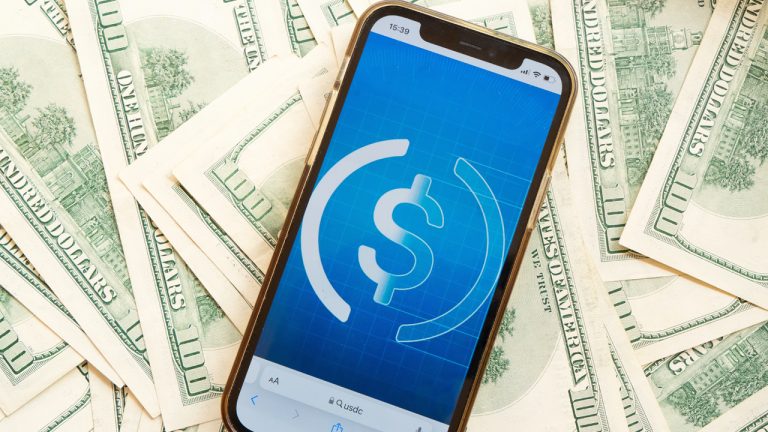 Statistics recorded on April 15, 2023, show that the number of coins in circulation for the stablecoin BUSD dropped below the 7 billion range to 6.68 billion, marking the lowest number of BUSD in circulation since April 2021. Furthermore, data indicates that the supply of BUSD has shrunk by 19.8% over the past 30 days. […]
Statistics recorded on April 15, 2023, show that the number of coins in circulation for the stablecoin BUSD dropped below the 7 billion range to 6.68 billion, marking the lowest number of BUSD in circulation since April 2021. Furthermore, data indicates that the supply of BUSD has shrunk by 19.8% over the past 30 days. […]
Tether supply across cryptocurrency exchanges has dropped 28% in 2023, however, hinting at an overall decline in demand for stablecoins.
Tether (USDT) continues to benefit from the ongoing turmoil in the U.S. dollar-backed stablecoin industry with its market capitalization growing significantly in Q1 2023 at other stablecoins' expense.
On April 6, the circulating market cap of USDT surpassed $80 billion for the first time since May 2022 with a gain of $15 billion so far in 2023.

On the other hand, the market caps of its chief rivals, namely USD Coin (USDC) and Binance USD (BUSD), fell by about $12 billion and $9.4 billion, respectively.

Crypto traders opted for Tether given the growing concerns around USD Coin and Binance USD.
Notably, USDC market capitalization slipped due to its $3.3 billion exposure to the now-collapsed Silicon Valley and Silvergate banks. While BUSD suffered after New York regulators ordered Paxos to shut down the stablecon's issuance.
USDC weathered the crisis after the Federal Deposit Insurance Corporation's assurance that they would make depositors at the insolvent banks whole. As a result, the stablecoin recovered its dollar peg after losing it at the peak of the banking crisis in mid March.

But a growing crypto crackdown in the U.S. has prompted investors to maintain distance from regional firms. For instance, Paxos confirmed that the Securities and Exchange Commission (SEC) treats BUSD as an unregistered security.
On the other hand, Tether is a non-U.S. firm and has repeatedly assured that it has no exposure to insolvent U.S. banks. Nonetheless, it keeps facing constant scrutiny over its reserve assets and lack of proper audits for years, despite such issues becoming less of a concern among traders.
Interestingly, the growth in the USDT circulating supply has coincided with a drop in its supply across exchanges.
Related: USDT issuer Tether has up to $1.7B in excess reserves, CTO says
Tether's balance on exchanges has dropped 28% YTD to 12.88 billion USDT, according to Glassnode. In comparison, the aggregated stablecoin balance across exchanges has dropped by 41% YTD to $22.31 billion.

The decline in stablecoin reserves coincides with a crypto market rally, suggesting that traders have been converting their crypto dollars to buy Bitcoin (BTC) and Ether (ETH).
This article does not contain investment advice or recommendations. Every investment and trading move involves risk, and readers should conduct their own research when making a decision.

Cross-chain bridging solution provider Allbridge is promising leniency to the hacker who exploited the multichain tool days ago if stolen funds are returned. While offering a “white hat bounty” to the hacker, Allbridge says that it won’t take legal action against the attacker if the funds are sent back. “Firstly, we propose a white hat […]
The post Hacker Offered Bounty After Exploiting $573,000 in Crypto From DeFi Platform appeared first on The Daily Hodl.

Binance.US said it temporarily disabled One Common Billing System and BUSD stablecoin pairs after halting Apple Pay and Google Pay deposits.
Amid the ongoing uncertainty around the global banking turmoil, Binance’s United States-based arm Binance.US is halting some services.
According to Binance.US status dashboard, the U.S. crypto exchange on March 31 disabled Binance USD (BUSD) stablecoin pairs via One Common Billing System, referred to as OCBS.
The affected services include BUSD crypto deposits and withdrawals, or buying, selling and converting crypto options, the status notice says.
Binance.US said that the firm is currently investigating the issue, noting that the services are “suspended temporarily.”

The OCBS and BUSD issues on Binance.US came shortly after the firm halted certain U.S. dollar deposit services on March 30. According to the dashboard, Binance.US temporarily suspended Apple Pay and Google Pay deposits due to the company “transitioning to new banking and payment service providers over the next several weeks.”
For up to 5% of Binance.US customers, the platform has also halted debit card deposits starting from March 30, 2023. “We are working to restore all services as soon as possible,” Binance.US stated.
Related: Kraken to suspend Plaid withdrawals and deposits via ACH Silvergate
The news comes amid Binance.US’ global affiliate, Binance, facing legal action from the U.S. Commodity Futures Trading Commission (CFTC). On March 27, the CFTC filed a suit against Binance and CEO Changpeng “CZ” Zhao for alleged trading violations, arguing that the exchange failed to meet compliance obligations by not registering with the regulator.
Launched in September 2019 and headquartered in California, Binance.US operates as a separate entity from Binance, which is not available to U.S. users due to local regulations.
Catherine Coley, the first CEO of Binance.US, reportedly enlisted a former federal prosecutor and top cop at the CFTC to represent her in the U.S. government’s investigations into Binance.US. After leaving Binance.US in June 2021, Coley has remained silent about her whereabouts in media and hasn’t posted anything on her Twitter.
Magazine: Unstablecoins: Depegging, bank runs and other risks loom

Binance assured users that the change would not impact them in any way and that their funds would continue to be held in publicly verifiable addresses.
Cryptocurrency exchange Binance announced on March 17 that it has replaced the Binance USD (BUSD) holdings in its Secure Asset Fund for Users (SAFU) with TrueUSD (TUSD) and Tether (USDT). The move comes in response to Paxos’ recent move to stop minting new BUSD, which has led to the asset’s market capitalization falling.
As Paxos will no longer be minting new BUSD, #Binance has swapped the BUSD in the SAFU Fund for TUSD & USDT.
— Binance (@binance) March 17, 2023
This change will have no impact on users, and the funds remain on publicly verifiable addresses.
Funds are SAFU.https://t.co/edLVgpdCUQ
SAFU is an emergency insurance fund established by Binance in July 2018 to protect users’ funds in case of security breaches or other unforeseen events. Binance committed a percentage of trading fees to grow the fund, which was valued at $1 billion as of Jan. 29, 2022. SAFU’s wallets initially consisted of BNB (BNB), Bitcoin (BTC) and Binance USD — which has now been replaced by TUSD and USDT.
Binance assured users that the change would not impact them, their funds would continue to be held in publicly verifiable addresses, and BUSD would continue to be supported. The exchange added that it would closely monitor the fund to ensure that it remains sufficiently capitalized and top it up periodically as necessary using its own funds.
On Feb. 13, BUSD issuer Paxos Trust Company announced it would stop issuing new BUSD effective Feb. 21 in accordance with the directions of and in coordination with the New York Department of Financial Services.
Related: Coinbase disables trading for BUSD
Days after reports emerged that United States regulators were scrutinizing Paxos and BUSD, Binance minted nearly $50 million worth of TUSD. The transaction took place on Feb. 16, according to data from Etherscan, and came two days after Binance CEO Chanpeng Zhao mentioned in a Feb. 14 Twitter Space that Binance would look to “diversify” its stablecoin holdings away from BUSD.
With the U.S. Securities and Exchange Commission also taking action against BUSD, some crypto community members have questioned whether stablecoins are the real issue at hand or if it’s actually about Binance, as the SEC didn’t take action against Paxos’ gold-backed stablecoin, Pax Gold (PAXG).
This is an excellent point. Paxos has been specifically targeted for BUSD, but not their own Pax dollar.
— Cryptohippo (@cryptohippo65) February 13, 2023
Look at the bigger picture. FTX collapsed, & now suddenly the regulators are coming after Binance.
It's almost as if a co-conspirator of Binance is informing on them. https://t.co/FhkrntttlK
 During the past 11 days, over 7 billion USDC stablecoins have been withdrawn from circulation, with most of the redemptions occurring following the depegging event of USDC on March 11, 2023. Furthermore, since March 6, a total of 439.48 million BUSD stablecoins have been redeemed. Stablecoin Depegging Event Triggers Billions in Redemptions The stablecoin landscape […]
During the past 11 days, over 7 billion USDC stablecoins have been withdrawn from circulation, with most of the redemptions occurring following the depegging event of USDC on March 11, 2023. Furthermore, since March 6, a total of 439.48 million BUSD stablecoins have been redeemed. Stablecoin Depegging Event Triggers Billions in Redemptions The stablecoin landscape […]
Coinbase assured users that their BUSD funds would remain accessible and they could still withdraw funds at any time.
United States-based cryptocurrency exchange Coinbase announced on March 13 that it had suspended trading for the Binance USD (BUSD) stablecoin.
We have disabled trading for Binance USD (BUSD). Your BUSD funds will remain accessible to you, and you will continue to have the ability to withdraw your funds at any time. https://t.co/jfpCZX7UTC
— Coinbase Assets (@CoinbaseAssets) March 13, 2023
In its initial Feb. 27 announcement, Coinbase cited “listing standards” as being behind its decision. The February announcement read:
“We regularly monitor the assets on our exchange to ensure they meet our listing standards. Based on our most recent reviews, Coinbase will suspend trading for Binance USD (BUSD) on March 13, 2023, on or around 12pm ET.”
According to Coinbase’s Feb. 27 Twitter thread, the decision applies to Coinbase.com (simple and advanced), Coinbase Pro, Coinbase Exchange and Coinbase Prime. On March 13, Coinbase assured its customers that “your BUSD funds will remain accessible to you, and you will continue to have the ability to withdraw your funds at any time.”
A Coinbase spokesperson explained to Cointelegraph at the time:
“Our determination to suspend trading for BUSD is based on our own internal monitoring and review processes. When reviewing BUSD, we determined that it no longer met our listing standards and will be suspended.”
Related: Coinbase CEO ponders banking features after Silicon Valley Bank crisis
On March 8, Coinbase introduced a new business solution called wallet-as-a-service (WaaS) to assist enterprises in offering Web3 wallets to their customers. WaaS provides customizable on-chain wallets through technical infrastructure, enabling enterprises to create and launch these wallets. Additionally, the wallet application programming interface provided by WaaS allows businesses to create wallets for simple customer onboarding, loyalty programs or in-game purchases.
On March 11, Coinbase assured customers that its staking services would continue and “may actually increase,” despite the recent crackdown by the United States Securities and Exchange Commission on staking services offered by centralized providers.

The USD Coin depeg led the DeFi protocol to experience a record-breaking daily trading volume as crypto whales fight for assets.
Stablecoin swapping pool Curve Finance is experiencing the highest daily trading volume in its history, exceeding $7 billion in the past 24 hours after the Silicon Valley Bank (SVB) collapse triggered a wave of uncertainty across markets and depegged the USD Coin (USDC) from the U.S. dollar.
Looks like we have the biggest daily trading volume in history
— Curve Finance (@CurveFinance) March 11, 2023
Curve supports liquidity pools for major stablecoins, such as USDC, Tether (USDT), Frax (FRAX), Dai (DAI) and TrueUSD (TUSD). Fear, doubt, and uncertainty have spread across crypto markets during the last few hours, resulting in unbalanced pools in the DeFi platform due to a sell-off of USDC, leading the major stablecoin price to fall below its $1 peg.
USDC is the second-biggest stablecoin, with a market cap of over $42 billion as of January 31, serving as collateral for many stablecoin ecosystems. Its depeg had an immediate effect on other stablecoins like DAI issued by MakerDAO, down 5% at the time of publication.
To prevent panic selling, MakerDAO filed an “urgent executive proposal to mitigate risks to the protocol” on March 11 seeking restrictions on minting DAI using USDC. MakerDAO is one of the largest holders of the stablecoin, with over 3.1 billion USDC ($2.85 billion) in reserves collateralizing DAI. Crypto whales have reported severe losses and appear to be fleeing their assets in an attempt to preserve capital, Cointelegraph reported.
Circle, the company behind the USDC, disclosed on March 11 that $3.3 billion of its $40 billion reserves were stuck in the Silicon Valley Bank, which was shut down the day before by the California Department of Financial Protection and Innovation. The watchdog also appointed the Federal Deposit Insurance Corporation (FDIC) as the receiver to protect insured deposits.
Silicon Valley Bank is one of six banking partners Circle uses for managing the ~25% portion of USDC reserves held in cash. While we await clarity on how the FDIC receivership of SVB will impact its depositors, Circle & USDC continue to operate normally.https://t.co/NU82jnajjY
— Circle (@circle) March 10, 2023
In comments to Cointelegraph, Dave Weisberger, co-founder and CEO of algorithmic-trading platform CoinRoutes, said that the “fodder for a broader contagion event is there” and that “the spark could be materializing,” putting at risk many startups and tech companies in the country — a critical sector for the “sustained growth of the American economy.”

Following USDC’s depegging, three stablecoins — DAI, USDD and FRAX — also depegged from the dollar.
The stablecoin ecosystem felt an immediate effect as USD Coin (USDC) depegged from the US dollar due to a subsequent sell-off after Silicon Valley Bank (SVB) did not process $.3.3 billion of Circle’s $40 million transfer request. Given USDC’s collateral influence, major stablecoin ecosystems followed suit in depegging from the dollar.
Dai (DAI), a stablecoin issued by MakerDAO, lost 7.4% of its value as a result of USDC’s depegging. As of June 2022, $6.78 billion worth of DAI supply was collateralized by $8.52 billion worth of cryptocurrencies, confirms data from Statista.

Out of the lot, USDC represented 51.87% of DAI’s collateral, worth $4.42 billion. Other prominent cryptocurrencies include Ether (ETH) and Pax Dollar (USDP) at $0.66 billion and $0.61 billion respectively.
As a result, DAI depegged from the dollar to momentarily touch $0.897. The stablecoin recovered to trade around the $0.92 mark at the time of writing, as shown below.

USD Digital (USDD), another stablecoin issued by Tron blockchain, and fractional-algorithmic stablecoin Frax (FRAX) shared a similar fate due to negative market sentiments. USDD responded to the USDC sell-off with a nearly 7.5% drop to trade at $0.925 while FRAX dipped even further to $0.885.

Other popular cryptocurrencies, such as Tether (USDT) and Binance USD (BUSD), continue to maintain a 1:1 peg with the US dollar.
Related: USDC investor shells out $2M to receive $0.05 USDT trying to evade crash
The entire depegging ordeal started after Circle announced that $3.3 billion of its funds were not processed for withdrawal by SVB.
1/ Following the confirmation at the end of today that the wires initiated on Thursday to remove balances were not yet processed, $3.3 billion of the ~$40 billion of USDC reserves remain at SVB.
— Circle (@circle) March 11, 2023
SVB was ordered to shut down by the California Department of Financial Protection and Innovation for undisclosed reasons. However, the California regulator appointed the Federal Deposit Insurance Corporation as the receiver to protect insured deposits.

Chatcasso won the first prize in the BNB Chain hackathon for creating an AI-powered tool for creating NFTs and won $5,000 in BUSD, held in Seoul between Dec. 17 to 19, 2022.
Crypto exchange Binance has been accused of “blatantly” copying the winner of the BNB Chain hackathon after launching Bicasso — an AI-based nonfungible token (NFT) creation tool. Binance allegedly ripped off a tool created by Chatcasso just two months after awarding them first prize in a BNB Chain hackathon held in Seoul between Dec. 17 to 19, 2022.
On March 1, Binance CEO Changpeng ‘CZ’ Zhao announced the launch of Bicasso, an artificial intelligence (AI) product that can be used to “turn your creative visions into NFTs with AI.” However, community member ggoma believes Binance copied his project Chatcasso and shipped it as their own offering.
"Keep building " - @cz_binance said.
— ggoma (@0xggoma) March 2, 2023
What he DIDN'T say - "If you guys build it well, we'll blatantly copy it and ship it as our product! "
Story of Binance stealing our project we won 1st place at the BNB Chain hackathon https://t.co/ejc5Z7w9o1
Binance, on the other hand, dismissed the accusations of stealing. Speaking to Cointelegraph, a Binance spokesperson said that Bicasso is an experimental project built by a small team at Binance as a test and that NFTs and AI are common concepts being worked on by many industry players.
Chatcasso won the first prize in the BNB Chain hackathon for creating an AI-powered tool for creating NFTs and won $5,000 in Binance USD (BUSD).

However, ggoma was shocked to see Binance lauch a similar platform within a span of two months, as he stated:
“A big company like Binance copying everything down to the name? It's not only unethical, but it's also confusing for users. The names are so similar that it's hard to tell them apart.”
In addition, ggoma shared screenshots of the two projects in an attempt to showcase the similarities between the user interface and capabilities.

Binance, however, maintains that the similarities does not imply theft of ideas. The exchange’s spokesperson told Cointelegraph:
“Despite the similarities, after conducting an internal review, we’re confident that Bicasso was designed and developed independently more than two weeks before the BNB hackathon.”
Moreover, Binance and BNB Chain operate separately and the Binance development team are not involved in BNB Chain hackathons, said the crypto exchange. On the other hand, ggoma showed displeasure with the similar names of the two platforms in question:
“A big company like Binance copying everything down to the name? It's not only unethical, but it's also confusing for users. The names are so similar that it's hard to tell them apart.”
Binance clarified to Cointelegraph that the name Bicasso was derived following inspiration from the OpenAI tool ‘Dall-E,’ which is a reference to the artist Dali, adding that “Our team loved this concept.”
The entire episode made ggoma skeptical of entering hackathons in the future as he wondered if his ideas would be rebranded by a market leader at a later stage. “We hope that Binance realizes the impact of their actions and takes steps to right their wrongs,” ggoma added while warning builders that “there are companies out there who will try to take advantage of your hard work.”
Binance’s Bicasso became an instant hit among NFT investors as the AI-powered NFT generator recorded 10,000 mints in 2.5 hours.
Related: Binance launches anti-scam campaign after Hong Kong pilot run
CZ recently warned investors that a photoshopped image with misinformation was being circulated on WeChat, a social media platform in China.
Someone photoshoped this, and it got spread widely on WeChat in china. It says I got shot by the FBI, whom our team work with closely… ♂️ 4. pic.twitter.com/2Iz7c1QgA8
— CZ Binance (@cz_binance) March 3, 2023
CZ further highlighted the importance of dismissing fear, uncertainty and doubt (FUD) and advised investors to ignore false allegations that crop up from time to time.